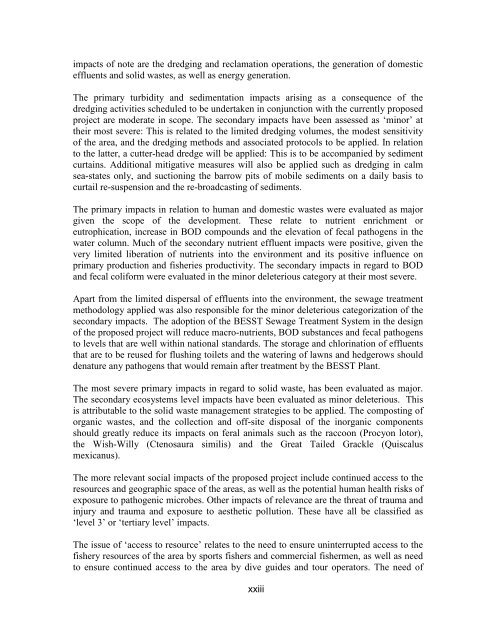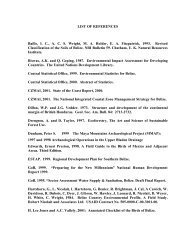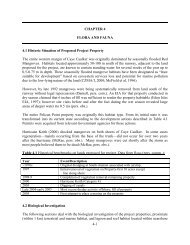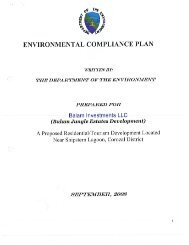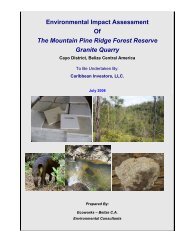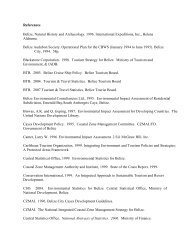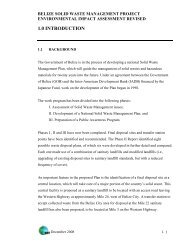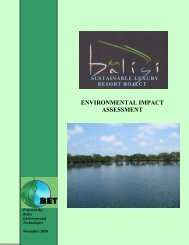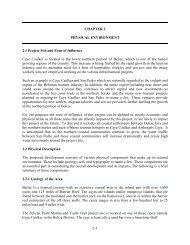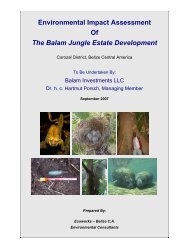Ambergris Caye Belize Resort Development - Department of ...
Ambergris Caye Belize Resort Development - Department of ...
Ambergris Caye Belize Resort Development - Department of ...
You also want an ePaper? Increase the reach of your titles
YUMPU automatically turns print PDFs into web optimized ePapers that Google loves.
impacts <strong>of</strong> note are the dredging and reclamation operations, the generation <strong>of</strong> domestic<br />
effluents and solid wastes, as well as energy generation.<br />
The primary turbidity and sedimentation impacts arising as a consequence <strong>of</strong> the<br />
dredging activities scheduled to be undertaken in conjunction with the currently proposed<br />
project are moderate in scope. The secondary impacts have been assessed as ‘minor’ at<br />
their most severe: This is related to the limited dredging volumes, the modest sensitivity<br />
<strong>of</strong> the area, and the dredging methods and associated protocols to be applied. In relation<br />
to the latter, a cutter-head dredge will be applied: This is to be accompanied by sediment<br />
curtains. Additional mitigative measures will also be applied such as dredging in calm<br />
sea-states only, and suctioning the barrow pits <strong>of</strong> mobile sediments on a daily basis to<br />
curtail re-suspension and the re-broadcasting <strong>of</strong> sediments.<br />
The primary impacts in relation to human and domestic wastes were evaluated as major<br />
given the scope <strong>of</strong> the development. These relate to nutrient enrichment or<br />
eutrophication, increase in BOD compounds and the elevation <strong>of</strong> fecal pathogens in the<br />
water column. Much <strong>of</strong> the secondary nutrient effluent impacts were positive, given the<br />
very limited liberation <strong>of</strong> nutrients into the environment and its positive influence on<br />
primary production and fisheries productivity. The secondary impacts in regard to BOD<br />
and fecal coliform were evaluated in the minor deleterious category at their most severe.<br />
Apart from the limited dispersal <strong>of</strong> effluents into the environment, the sewage treatment<br />
methodology applied was also responsible for the minor deleterious categorization <strong>of</strong> the<br />
secondary impacts. The adoption <strong>of</strong> the BESST Sewage Treatment System in the design<br />
<strong>of</strong> the proposed project will reduce macro-nutrients, BOD substances and fecal pathogens<br />
to levels that are well within national standards. The storage and chlorination <strong>of</strong> effluents<br />
that are to be reused for flushing toilets and the watering <strong>of</strong> lawns and hedgerows should<br />
denature any pathogens that would remain after treatment by the BESST Plant.<br />
The most severe primary impacts in regard to solid waste, has been evaluated as major.<br />
The secondary ecosystems level impacts have been evaluated as minor deleterious. This<br />
is attributable to the solid waste management strategies to be applied. The composting <strong>of</strong><br />
organic wastes, and the collection and <strong>of</strong>f-site disposal <strong>of</strong> the inorganic components<br />
should greatly reduce its impacts on feral animals such as the raccoon (Procyon lotor),<br />
the Wish-Willy (Cteno saura similis) and the Great Tailed Grackle (Quiscalus<br />
mexicanus).<br />
The more relevant social impacts <strong>of</strong> the proposed project include continued access to the<br />
resources and geographic space <strong>of</strong> the areas, as well as the potential human health risks <strong>of</strong><br />
exposure to pathogenic microbes. Other impacts <strong>of</strong> relevance are the threat <strong>of</strong> trauma and<br />
injury and trauma and exposure to aesthetic pollution. These have all be classified as<br />
‘level 3’ or ‘tertiary level’ impacts.<br />
The issue <strong>of</strong> ‘access to resource’ relates to the need to ensure uninterrupted access to the<br />
fishery resources <strong>of</strong> the area by sports fishers and commercial fishermen, as well as need<br />
to ensure continued access to the area by dive guides and tour operators. The need <strong>of</strong><br />
xxiii


